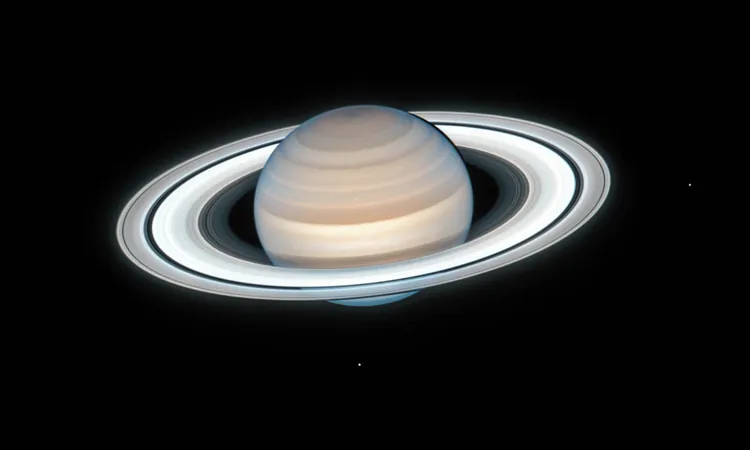
The Countdown Begins: Saturn's Spectacular Rings Set to Disappear!
2025-01-13
Author: Ling
Saturn's Iconic Rings and Their Historical Significance
Saturn, renowned for its breathtaking beauty, has enchanted stargazers for centuries with its iconic rings, which many consider the jewel of our solar system. This magnificent planet has a rich history, dating back to 17th-century observations by Italian astronomer Galileo Galilei, who famously described Saturn as having "ears," a quaint reflection of the limited technology available at the time.
An Astronomical Marvel Unveiled
With advancements in modern telescopes and observatories, our understanding of Saturn has drastically evolved. We now know that its rings are not just decorative; they provide crucial insights into the gravitational forces shaping our solar system. By analyzing Saturn's rings, astronomers are piecing together the complex interactions between celestial bodies and the physics of orbital mechanics.
Recent research by Jonah Peter, a doctoral candidate at the Harvard-Smithsonian Center for Astrophysics, sheds light on the relationship between Saturn's moons and the dynamics of its rings. Through his studies, Peter connects the enigmatic behaviors of the ring particles to the broader mechanics of our cosmic surroundings.
A Rare Astronomical Event Approaches
A celestial spectacle is on the horizon! On March 23, 2025, a phenomenon known as "ring plane crossing" will occur, causing Saturn's magnificent rings to seemingly vanish from our view. This fleeting moment arises as Saturn's tilt aligns with our perspective, reducing the rings to a thin edge that disguises their grandeur.
For a period, observers will see Saturn as a pale yellow sphere, with only the most powerful telescopes revealing the faint outline of its rings. Though some may mourn the temporary loss of this awe-inspiring sight, the excitement of witnessing the rings return in late 2025 will surely make it worthwhile!
Structure and Composition of the Rings
Saturn's rings are organized into several sections, commonly referred to as the A, B, and C rings, along with fainter D, E, F, and G rings. The well-known Cassini Division rests between the A and B rings, a space formed by the gravitational dynamics at play in the Saturnian system.
The rings consist of countless icy particles, ranging in size from tiny grains of dust to massive boulders. Some scientists theorize that Saturn's rings originated from a moon torn apart by the planet's powerful gravity, while others suggest that they are remnants from the planet's formation over four billion years ago.
The Role of Saturn's Moons
The Saturnian system is home to over 145 moons, with some acting as "shepherd moons" that help maintain the structure of the rings by holding particles in place with their gravitational pull. This intricate relationship keeps the rings in order and preserves their distinct gaps and bands.
Perhaps most intriguing is Titan, Saturn's largest moon, which has been a focal point for scientific exploration. With a thick nitrogen-rich atmosphere, Titan exhibits unique geological features, including lakes filled with liquid hydrocarbons. NASA's Dragonfly mission aims to explore this mysterious moon further, potentially unveiling clues about the formation of exotic landscapes and the possibility of life beyond our planet.
Could Enceladus Harbor Life?
Another moon, Enceladus, represents another frontier in the search for extraterrestrial life. Its icy plumes, which spew water vapor and organic compounds, have captured the attention of scientists, particularly following discoveries made during the Cassini mission. Jonah Peter highlights Enceladus's potential for habitability, stating it could be a hotspot for life beyond Earth.
The Everlasting Mystery of Saturn
Galileo's early observations remind us of the boundless wonders that the cosmos holds. While the rings may fade momentarily from our view, their return will reaffirm the dynamic nature of Saturn. Each shift in our perspective encourages astronomers and enthusiasts alike to continue exploring this celestial titan.
So, prepare your telescopes and mark your calendars for March 2025; the breathtaking beauty of Saturn's rings will be temporarily eclipsed, but the thrill of the wait will only amplify the excitement of their eventual return!



 Brasil (PT)
Brasil (PT)
 Canada (EN)
Canada (EN)
 Chile (ES)
Chile (ES)
 Česko (CS)
Česko (CS)
 대한민국 (KO)
대한민국 (KO)
 España (ES)
España (ES)
 France (FR)
France (FR)
 Hong Kong (EN)
Hong Kong (EN)
 Italia (IT)
Italia (IT)
 日本 (JA)
日本 (JA)
 Magyarország (HU)
Magyarország (HU)
 Norge (NO)
Norge (NO)
 Polska (PL)
Polska (PL)
 Schweiz (DE)
Schweiz (DE)
 Singapore (EN)
Singapore (EN)
 Sverige (SV)
Sverige (SV)
 Suomi (FI)
Suomi (FI)
 Türkiye (TR)
Türkiye (TR)
 الإمارات العربية المتحدة (AR)
الإمارات العربية المتحدة (AR)